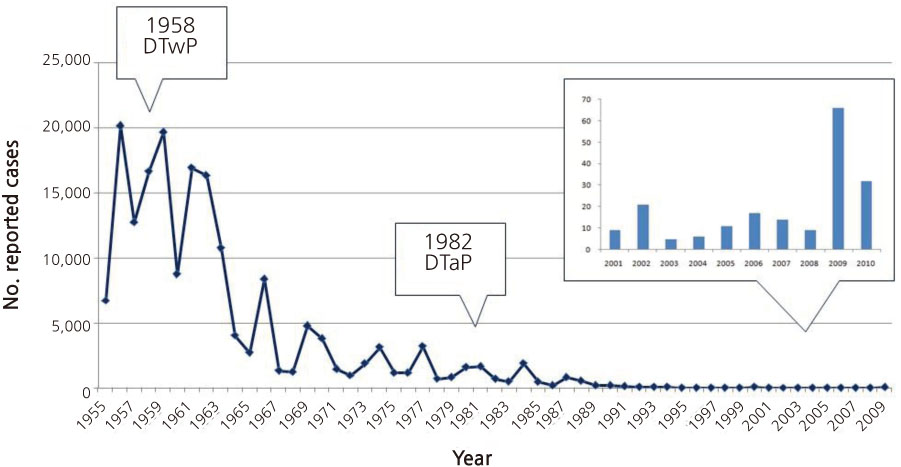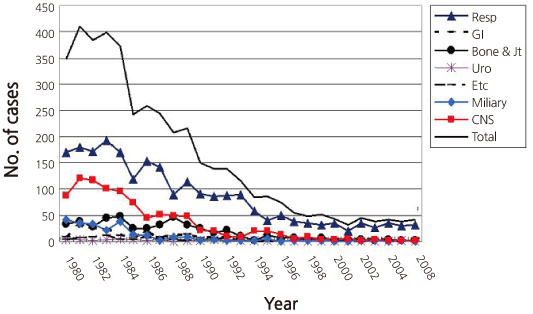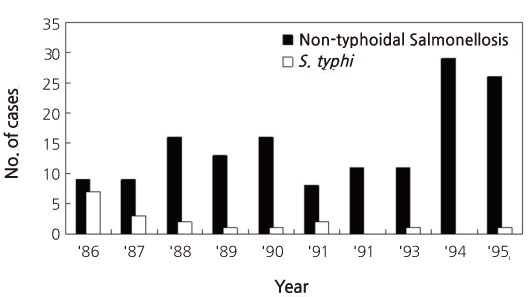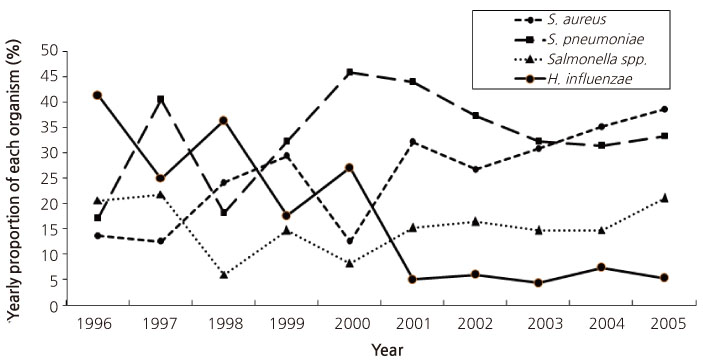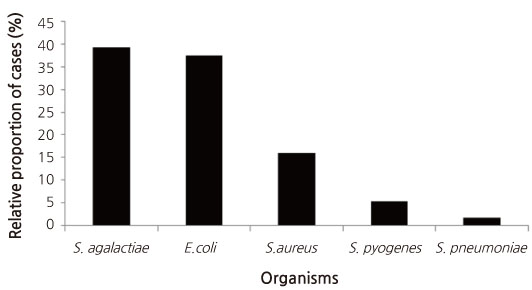Infect Chemother.
2011 Dec;43(6):468-473. 10.3947/ic.2011.43.6.468.
Trends in Childhood Bacterial Infectious Diseases in the Republic of Korea
- Affiliations
-
- 1Division of VPD control and NIP, Korea Centers for Disease Control and Prevention, Seoul, Korea.
- 2Department of Pediatrics, Seoul National University College of Medicine, Seoul, Korea. hoanlee@snu.ac.kr
- KMID: 2170358
- DOI: http://doi.org/10.3947/ic.2011.43.6.468
Abstract
- Bacterial infections have been the main threat to childhood health in Korea for the past 50 years. The economic growth and societal transition of the country during last century has made for an impressive story of success in the continuous reduction and effective control of both mortality from, and morbidity of, childhood bacterial infections. Many factors, including improved sanitation and living conditions, the introduction of antibiotics and vaccines, and the improvement of health care and settle down of surveillance systems, have contributed significantly to such success. However, childhood bacterial infections still play a significant role in child health from a clinical perspective, since the etiologic agents of invasive bacterial infections have changed following the changes in the environment and human behavior in the country. In order to meet this challenge, solid scientific knowledge and understanding of childhood bacterial infectious diseases during the last century are necessary. With transitions in epidemiology and microbiological characteristics, careful monitoring and building of scientific evidence are also needed in the to sustain and decrease the disease burden of childhood bacterial infections in Korea.
Keyword
MeSH Terms
Figure
Cited by 1 articles
-
Etiology and Clinical Features of Acute Bacterial Gastroenteritis in Children Mananged at a Secondary Hospital
Sung Yoon Kim, Hyun-Jung Kim, Eun Hye Shin, Byung Wook Eun, Young Min Ahn, Mi Ok Song
Pediatr Infect Vaccine. 2017;24(2):95-101. doi: 10.14776/piv.2017.24.2.95.
Reference
-
1. National notifiable infectious diseases reports. Korea Centers for Disease Control and Prevention. Accessed 29 November 2011. Available at: http://www.cdc.go.kr/.2. Sohn KC, Cho SS, Doh KC, Choi Y, Chung KS, Kum DH, Kim ST. Statistical observation for pediatric inpatients. J Korean Pediatr Soc. 1984. 27:1–8.3. Kim HH, Shin KH, Kim SN, Lee MS, Yoo SH, Kim JY, Kang JH. Investigation on the immunity to pertussis in the Korea. J Korean Soc Microbiol. 1999. 34:583–589.4. Seo HK, Kim RH, Kim SH, Kim HY, Park SE, Park HJ, Lee SJ, Kim HJ. Three cases of pertussis in infants younger than three months without immunization of DTaP. Pediatr Allergy Respir Dis. 2011. 21:56–60.
Article5. Kwon YJ, Choi JY, Chang JS. Clinical observation of neonatal tetanus. J Korean Pediatr Soc. 1969. 12:33–39.6. Korea Advisory Committee on Immunization Practices. Tetanus. Epidemiology and prevention of vaccine-preventable diseases. 2011. 4th ed. Seoul: Young Chang Press;123–138.7. Kim JH. Update on tuberculosis in children and adolescents. Korean J Pediatr Infect Dis. 2009. 16:107–114.
Article8. Lee KS, Chung KS, Ryoo KY, Lee WG, Kang SJ, Lee SB, Sung IK. Statistical analysis of pediatric diseases in Korea (1987). J Korean Pediatr Soc. 1989. 32:885–896.9. Lew WJ. Tuberculosis situation in Korea. Tuberc Respir Dis. 1999. 46:301–310.
Article10. Kwun JW, Lee CH. Trends of recent food-borne disease outbreaks in Korea. J Korean Med Assoc. 2007. 50:573–581.
Article11. Lee JC, Jeong YS, Oh JY, Kang HY, Kim KH, Kim J, Lee YC, Cho DT, Seol SY. Epidemiology of shigellosis in Korea. J Bacteriol Virol. 2006. 36:41–49.
Article12. The annual frequency of shigellosis in Korea. Korea National Institute of Health. Accessed 30 November 2011. Available at: http://www.cdc.go.kr.13. Yoo S, Pai H, Byeon JH, Kang YH, Kim S, Lee BK. Epidemiology of Salmonella enterica serotype typhi infections in Korea for recent 9 years: trends of antimicrobial resistance. J Korean Med Sci. 2004. 19:15–20.
Article14. Nah SY, Park JY, Lee HJ, Seo JK. Epidemiologic and clinical features of salmonellosis in children over 10 years(1986-1995). Korean J Infect Dis. 1999. 31:129–135.15. Kim HH, Kang YH, Kim SH, Park MS, Yu JY, Lee BK. Serogroup and verocytotoxin productivity of Escherichia coli isolated from diarrheal patients in Korea. Korean J Infect Dis. 1998. 30:460–464.16. Cho HS, Cho MC, Noh S, Kim MN, Kim KM. A case of verotoxin-producing Escherichia coli O157:H7 with hemorrhagic colitis in an infant, diagnosed by multiplex PCR. Korean J Clin Microbiol. 2010. 13:85–89.
Article17. Korea Centers for Disease Control and Prevention (KCDC). Outbreak of EHEC in Gwangju. Commun Dis Mon Rep. 2004. 15:163–164.18. Lee HJ, Cheong HI, Choi Y, Shin MJ, Moon HR. Epidemic of acute renal failure and Kawasaki disease-like illness cuased by Yersinia pseudotuberculosis infection. J Korean Med Assoc. 1988. 31:747–756.19. Paik IK, Cho CR, Kim MA. Epidemiological investigation of Yersinia pseudotuberculosis infection in Korean. Korean J Clin Pathol. 1997. 17:1068–1075.20. Chang JY, Choi JE, Shin S, Yoon JH. Diagnosis of enteropathogens in children with acute gastroenteritis: one year prospective study in a single hospital. Korean J Pediatr Gastroenterol Nutr. 2006. 9:1–13.
Article21. Huh S, Yang MH, Kim BK, Park KS. The clinical observations of empyema thoracis in childhood. J Korean Pediatr Soc. 1970. 13:503–509.22. Kim AR, Kee BK, Lee MH. Clinical observation of pediatric empyema. J Korean Pediatr Soc. 1981. 24:48–53.23. Yum HY, Kim WK, Kim JT, Kim HH, Rha YH, Park YM, Sohn MH, Ahn KM, Lee SY, Hong SJ, Lee HR. The causative organisms of pediatric empyema in Korea. Korean J Pediatr. 2007. 50:33–39.
Article24. Nam SG, Lee HJ. Etiology of invasive bacterial infections in apparently healthy children. Korean J Infect Dis. 1998. 30:227–234.25. Lee JH, Song EK, Lee JA, Kim NH, Kim DH, Park KW, Choi EH, Lee HJ. Clinical entities and etiology of invasive bacterial infections in apparently healthy children. Korean J Pediatr. 2005. 48:1193–1200.26. Kim JS, Jang YT, Kim JD, Park TH, Park JM, Kilgore PE, Kennedy WA, Park E, Nyambat B, Kim DR, Hwang PH, Kim SJ, Eun SH, Lee HS, Cho JH, Kim YS, Chang SJ, Huang HF, Clemens JD, Ward JI. Incidence of Haemophilus influenzae type b and other invasive diseases in South Korean children. Vaccine. 2004. 22:3952–3962.
Article27. Kim KH, Sohn YM, Kang JH, Kim KN, Kim DS, Kim JH, Kim CH, Shin YK, Oh SH, Lee HJ, Cha SH, Hong YJ, Sohn KC. The causative organisms of bacterial meningitis in Korean children, 1986-1995. J Korean Med Sci. 1998. 13:60–64.
Article28. Lee JH, Cho HK, Kim KH, Kim CH, Kim DS, Kim KN, Cha SH, Oh SH, Hur JK, Kang JH, Kim JH, Kim YK, Hong YJ, Chung EH, Park SE, Choi YY, Kim JS, Kim HM, Choi EH, Lee HJ. Etiology of invasive bacterial infections in immunocompetent children in Korea (1996-2005): a retrospective multicenter study. J Korean Med Sci. 2011. 26:174–183.
Article29. Choi E. Direct and indirect effects of pneumococcal protein conjugate vaccine. J Korean Med Assoc. 2008. 51:119–126.
Article30. Kwak YH, Kim YJ, Jung HS, Hong JY, Lee HJ. Clinical features of Group B β-hemolytic streptococcal infection in infants and children. Korean J Pediatr Infect Dis. 1999. 6:194–202.
Article31. Park KH, Kim KH, Kang JH, Kim KN, Kim DS, Kim YK, Kim JS, Kim JH, Kim CH, Kim HM, Oh SH, Chung EH, Cha SH, Choi YY, Hur JK, Hong YJ, Park SE, Lee HJ. Current status and clinical presentations of invasive neonatal Group B streptococcal infections in Korea. Pediatr Int. 2011. 53:236–239.
Article
- Full Text Links
- Actions
-
Cited
- CITED
-
- Close
- Share
- Similar articles
-
- Trends in gastrointestinal infections before and during non-pharmaceutical interventions in Korea in comparison with the United States
- Emerging Infectious Diseases in the Republic of Korea
- Increasing trends in mortality and costs of infectious diseases in Korea: trends in mortality and costs of infectious diseases
- Trends of Bacterial Zoonoses in Humans in Korea
- A Review of Childhood Obesity

